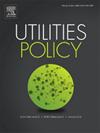印度海得拉巴的家庭用水变化
IF 4.4
3区 经济学
Q3 ENERGY & FUELS
引用次数: 0
摘要
第六个可持续发展目标(SDG)强调普遍获得水和卫生设施的重要性,特别注重确保公平的日常供水。我们研究了印度海得拉巴的水消费模式,重点研究了人均日用水量的季节和空间变化。本研究采用单样本t检验和分类回归树(CART)来调查用水量水平。对海得拉巴440户家庭进行了初步调查,分为31个小组。从家庭中收集感知用水数据以研究消费模式。研究发现,印度城市人均每天135升的服务水平基准(SLB)与家庭层面的年度和冬季平均水平相对应。在夏季和雨季,在被调查的家庭中观察到135个LPCD的显著变化。家庭特征、建筑特征、水源、供应特征、应对机制、器具和消费者行为影响家庭用水。该研究强调,需要考虑季节性需求和空间尺度(家庭、圈子和城市层面),以实现有效的水管理。结果表明,135 LPCD的SLB对应于城市和圈等更大空间尺度上的需水量。然而,在较小的空间尺度上,如家庭层面,它的相关性有限。这项研究有助于了解印度城市的人均用水量是如何随季节和空间尺度而变化的。对这些空间和季节消费变化的研究有助于供水工程的有效规划和实施。本文章由计算机程序翻译,如有差异,请以英文原文为准。
Variations in domestic water consumption in Hyderabad, India
The sixth Sustainable Development Goal (SDG) emphasizes the importance of universal access to water and sanitation, with a particular focus on ensuring an equitable daily water supply. We examine water consumption patterns in Hyderabad, India, with a focus on seasonal and spatial variations in daily per capita water consumption. The study employs one-sample t-tests and Classification and Regression Trees (CART) to investigate water consumption levels. A primary survey of 440 households was conducted in Hyderabad, divided into 31 circles. The perceived water usage data were collected from households to study consumption patterns. The study finds that the Service Level Benchmark (SLB) of 135 liters per capita per day (LPCD) for Indian cities corresponds to annual and winter averages at the household level. Significant variation from 135 LPCD was observed during the summer and rainy seasons in the surveyed households. Household characteristics, building characteristics, water sources, supply characteristics, coping mechanisms, appliances, and consumer behavior impact water consumption in households. The study highlights the need to consider seasonal demands and spatial scales (household, circle, and city levels) for effective water management. The findings indicate that the SLB of 135 LPCD corresponds to the water demands at larger spatial scales, such as the city and the circle. However, it has limited relevance at smaller spatial scales, such as the household level. The study helps to understand how per capita water consumption varies across seasons and spatial scales in an Indian city. The study of these spatial and seasonal consumption variations helps in the effective planning and implementation of water supply projects.
求助全文
通过发布文献求助,成功后即可免费获取论文全文。
去求助
来源期刊

Utilities Policy
ENERGY & FUELS-ENVIRONMENTAL SCIENCES
CiteScore
6.80
自引率
10.00%
发文量
94
审稿时长
66 days
期刊介绍:
Utilities Policy is deliberately international, interdisciplinary, and intersectoral. Articles address utility trends and issues in both developed and developing economies. Authors and reviewers come from various disciplines, including economics, political science, sociology, law, finance, accounting, management, and engineering. Areas of focus include the utility and network industries providing essential electricity, natural gas, water and wastewater, solid waste, communications, broadband, postal, and public transportation services.
Utilities Policy invites submissions that apply various quantitative and qualitative methods. Contributions are welcome from both established and emerging scholars as well as accomplished practitioners. Interdisciplinary, comparative, and applied works are encouraged. Submissions to the journal should have a clear focus on governance, performance, and/or analysis of public utilities with an aim toward informing the policymaking process and providing recommendations as appropriate. Relevant topics and issues include but are not limited to industry structures and ownership, market design and dynamics, economic development, resource planning, system modeling, accounting and finance, infrastructure investment, supply and demand efficiency, strategic management and productivity, network operations and integration, supply chains, adaptation and flexibility, service-quality standards, benchmarking and metrics, benefit-cost analysis, behavior and incentives, pricing and demand response, economic and environmental regulation, regulatory performance and impact, restructuring and deregulation, and policy institutions.
 求助内容:
求助内容: 应助结果提醒方式:
应助结果提醒方式:


